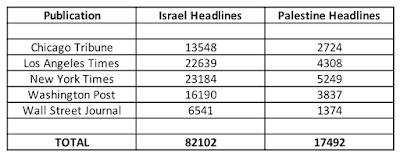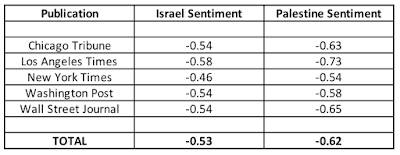
A recent study "50 Years of Occupation" by 416Labs analyzes 50 years of reporting on Israel and Palestine by five major United States newspapers including the Washington Post, New York Times, Lost Angeles Times, Wall Street Journal and Chicago Tribune, looking to see whether these five news sources have been balanced in their coverage of Israel and Palestine since the June 1967 Six Day War. With news being a very significant shaper of public opinion, this study is key to understanding how our views on the five-decade-long occupation of the West Bank and Gaza are framed.
The study involves the use of Natural Language Processing or NLP which uses computers to sift through massive amounts of data, tabulating the most commonly used words and word pairs and the positive or negative sentiments. The authors used NLP techniques to assess news coverage as follows:
1.) Sentiment analysis – measures the degree to which individual words and sentences can be classified as "positive", "negative" or "neutral". NLP is used to categorize a text's overall sentiment polarity by summing the number of positive, negative and neutral words. Scores were calculated with reference to a standard list of words that have been classified as either positive or negative with words external to the list being classified as neutral. Negative sentiment was assigned to headlines with a score of less than zero and positive sentiment was assigned to headlines with a score of greater than zero.
2.) Unigrams and Bigrams (n-grams) – headlines are filtered to remove "stop words" like "a" or "the" and n-grams (unigrams/bigrams) that are associated with the headlines. Words with a higher frequency provide insights into the themes and content of the articles. Bigrams provide insight into how certain terms tend to cluster together (i.e. West and Bank). N-grams were used in three contexts – overall aggregate basis across all five newspapers, by publication and by decade.
Here are some of the interesting results of the study:
1.) the number of headlines citing Israel over the 50 year period is more than four times the headlines citing Palestine as shown here:
This clearly shows that the Israeli narrative finds far greater coverage in the U.S. media than the Palestinian narrative.
Here is a table showing the sentiment scores for both Israel and Palestine:
On average, the sentiment score for both Israel and Palestine is negative, however, headlines for Israel were more positive than those for Palestine. A total of 44 percent of all Israeli headlines were negative compared to 48 percent of unique Palestine headlines. Only 11.1 percent of Israel headlines were positive compared to 10.7 percent of Palestine-related headlines.
When looking at n-grams, the major themes captured by both unigrams and bigrams extracted from headlines from both Israel and Palestine included terms that related to violence, state/security institutions, government officials and diplomatic overtures.
Here is a sample listing of the top 30 bigrams linked to Israel:
Peace Talks
Aid Israel
Peace Plan
US Israel
Mideast Peace
Visit Israel
Talks Israel
Here is a sample listing of the top 30 bigrams linked to Palestine:
Palestinian Police
Palestinians Killed
Killed Gaza
Killed West
Shot Dead
Palestinian Guerrillas
Gaza Hamas
Here is a quote from the paper about the differences in bigrams between Israel and Palestine:
"Another key theme that arises is the privileging of Israeli voices and, invariably, Israeli narratives. To put it in quantifiable terms, the bigram “Israel Says” and “Says Israel”, are two of the most frequent bigrams in the corpus, implying that Israeli sources are a standard part of headline construction. For example, the overall frequency of the term, ‘Says Israel’ and variations of it are almost two and a half times as likely to appear in the Israeli corpus as the term ‘Says Palestinian” and its affiliated bigrams in the Palestine dataset. Hence, it is evident that not only do Israeli voices and sources outnumber Palestinian ones but are also a critical part in reporting on matters related to Israel." (my bold)
The authors also noted a significant decline in the use of the term "occupation" as the decades passed; from the late 1960s until the end of the 1980s, there was a 42 percent decline in the instances of the word occupation and its affiliated unigrams and a further drop of 70 percent from the 1990s to the 2010s, resulting in a total drop of 85 percent.
Let's close this posting with a quote from the conclusion of the study:
Our results support previous research and claims that the U.S. mainstream media’s coverage of the issue favours Israel by providing greater access to Israeli officials, focusing on Israeli narratives both in terms of the quantity of coverage as well as the overall sentiment, as conveyed by headlines.
This is in marked contrast to the Palestinians, who are consistently underrepresented as well as covered more negatively. Furthermore, key elements of the conflict are understated, likely not to provide readers of these publications the full nature and complexities of Israel’s over 50- year occupation of the Palestinians."
This study shows us that the pro-Israel narrative has become so firmly entrenched in the American mainstream media that it is almost impossible for news consumers to discern the truth about the situation in Israel and Palestine. This has greatly benefitted Washington which has made it abundantly clear that it sides with Israel in this fifty year-old conflict.
Click HERE to read more from this author.
You can publish this article on your website as long as you provide a link back to this page.



Be the first to comment